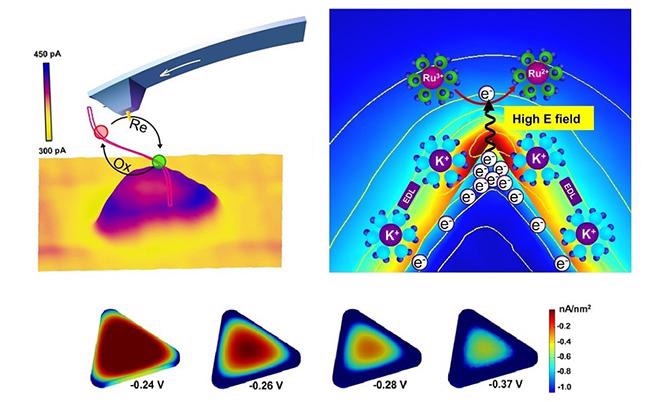Reviewed by Alex SmithNov 24 2021
Electrochemical processes become difficult to understand and control when there is an interaction between electron transfer (ET) and catalytic reaction at the surface of the electrocatalyst.
 Electron transfer current followed the trend: corner> edge> basal plane, driven by the interfacial inner potential differences. Image Credit: Wei Nie and Fengtao Fan.
Electron transfer current followed the trend: corner> edge> basal plane, driven by the interfacial inner potential differences. Image Credit: Wei Nie and Fengtao Fan.
Hence, it is vital to gain insights into the overall electrochemical reaction process that occurs at active sites to experimentally ascertain which ET process occurs at the nanoscale.
Most recently, a team of researchers headed by Professor Can Li and Professor Fengtao Fan from the Dalian Institute of Chemical Physics (DICP) of the Chinese Academy of Sciences (CAS) successfully performed imaging of the electron transfer in the electrocatalysis process.
This study was reported in the journal Nano Letters on October 14th, 2021.
The team discovered an in-situ electrochemical imaging technique that features nanoscale spatial resolution. The new technique integrated scanning electrochemical imaging and atomic force microscopy. It can achieve the three-dimensional movement of the scanning nanoprobe to trace the local distribution of the outer-spherical electron transfer molecules and the catalytic product molecules that are produced.
The images of visual electron transfer on metal nanoplates directly showed that the process of electron transfer at nanoscale presented a site-dependent heterogeneity.
Furthermore, the team decoupled the interference of the effect of mass transfer on the electron transfer by carrying out a range of detailed experiments and complex mathematical modeling to find out the rate constant and internal potential variation. They identified that the relationship between the rate constant and the interfacial inner potential variation proceeded in a linear fashion.
This study helped achieve the in-situ observation of the process of electron transfer and catalytic reaction in the electrochemical reaction. It also offers new concepts for the development of in-situ imaging characterization techniques and the identification of the mechanism of electrocatalytic reactions.
This is a new milestone of the scanning electrochemical probe techniques, making it possible to discover the structure-performance relation of nanocatalyst from the bottom of physical and chemical principles.
Noted one of the reviewers.
Journal Reference:
Nie, W., et al. (2021) Visualizing the Spatial Heterogeneity of Electron Transfer on a Metallic Nanoplate Prism. Nano Letters. doi.org/10.1021/acs.nanolett.1c03529.